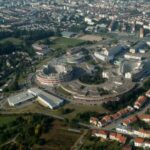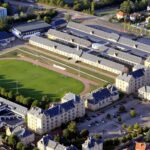A phytotron is a research instrument in plant biology. It allows plant growth in a confined space in which the climatic parameters are regulated. These parameters are temperature, hygrometry, lighting (intensity, spectrum, period) and also the composition of the atmosphere (CO2, ozone, etc.).
As a consequence, the phytotron is equipped with adapted lighting (sodium and halide discharge lamps, fluorescent tubes, incandescent lamp or DEL), temperature control and humidifiers generating water vapor. Climatic parameters are programmed to simulate climatic changes, continuously monitored and recorded.
Necessity of growth areas
The research programs of the laboratories using the facilities of the federative platform PEPLor involve experiments on plants and require to be able to control and record the culture parameters regulating the growth and development of the plants or systems studied. Some research activities are part of a context of climate change and require to be able to control the culture conditions, including temperature, light, hygrometry, and even the concentration of CO2 and/or ozone in the atmosphere.
Laboratories can use specific devices available on certain sites of the platform to grow GMOs, to mimic atmospheric pollution, or to study plant-pathogen interactions, metal assimilation, phytoremediation processes, mycorrhizal symbioses, dissipation of organic pollutants such as PAHs in the rhizosphere, soil toxicity with plant models, … (Inhibition of root growth (ISO 11269-1), emergence and growth of higher plants (ISO 1169-2, OECD 208), aquatic ecotoxicity tests with plant models: chronic toxicity test – Inhibition of growth of freshwater algae (ISO 8692).
Key figures of the hub
OBJECTIVE AND MISSIONS OF THE HUB
- To provide experimental devices to understand and exploit the adaptation of plants to their environment, to promote plant production, interesting molecule production (biomolecules) beneficial for the plant itself (defene, bio-control) or for humans (health value, cosmetics, pharmacology)
- To develop tools for assessing the bioavailability of pollutants, predicting their transfer to plants, and models for the design and management of crops on soils contaminated by trace elements or organic molecules.
Thus, operational and efficient phytotrons made available by the hub allow and promote:
- Obtaining original and robust data for the production of high-level knowledge that can be published in international peer-reviewed scientific journals,
- The attractiveness of the laboratories to young scientists,
- Obtaining financial resources from user laboratories through research partnerships with industries,
- To ensure scientific training of students.
location of sites

ENSAIA
2 avenue de la Forêt de Haye
BP 20163
54505 VANDOEUVRE-LES-NANCY

Faculty of Sciences and Technologies
Campus Aiguillettes
BP 70239
54506 VANDOEUVRE-LES-NANCY CEDEX

Bridoux Campus
Rue du Général Delestraint
57070 METZ



